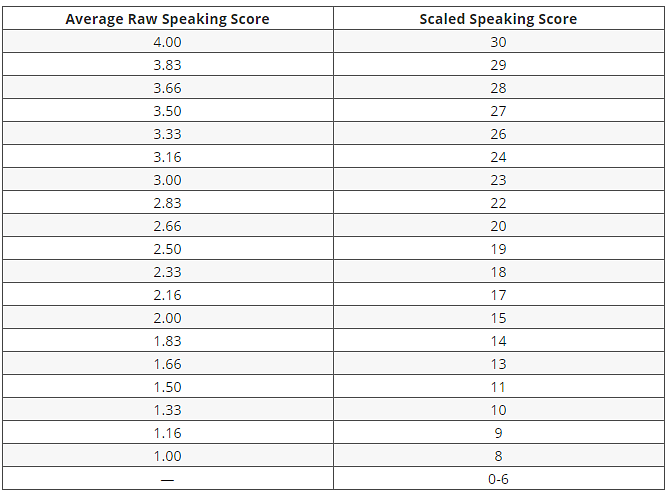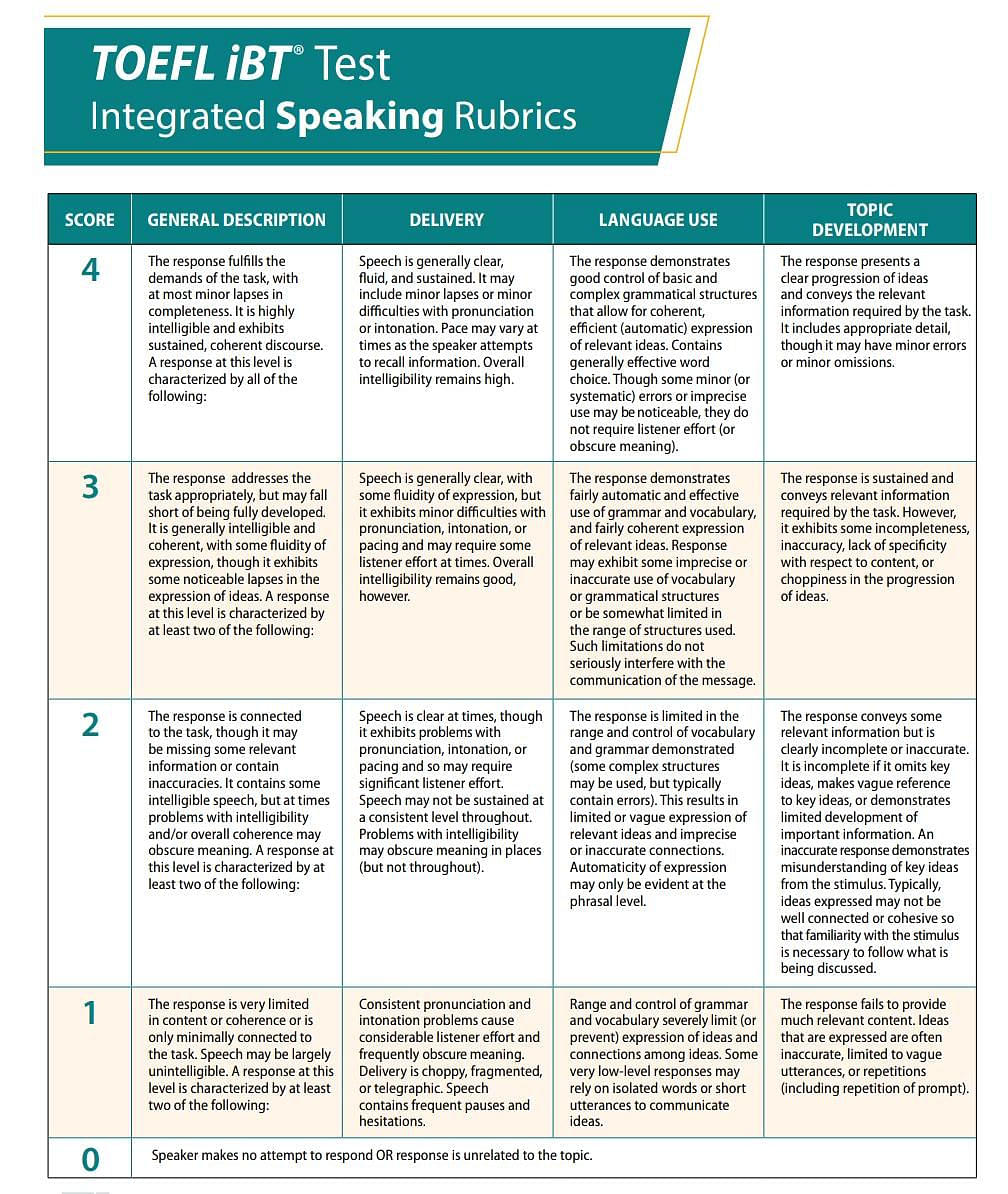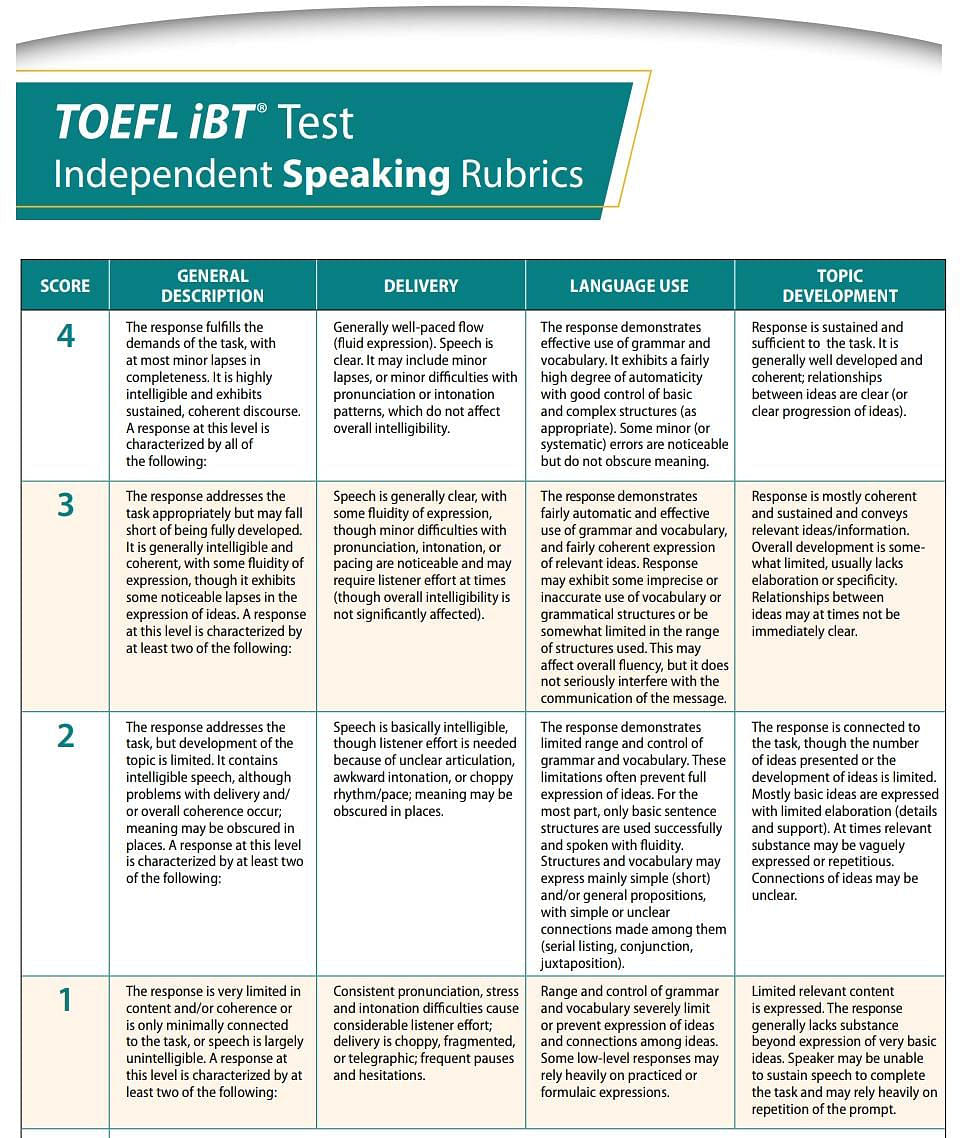
bySayantani Barman Experta en el extranjero
TOEFL Speaking comprises six tasks where the first two tasks are independent and the last four tasks are integrated. For each independent task in TOEFL speaking exam, you will get 45 seconds to put forward your opinion. For each TOEFL integrated task, you will get 60 seconds to speak out. Human raters are assigned for TOEFL speaking score and the band score is scaled from 0-4. These scores are then averaged again to give a raw score also on a scale of 0-4.
TOEFL Speaking Overview
The TOEFL speaking section tests the candidate’s speaking ability and fluency - both of which are necessities for staying and studying abroad.
- TOEFL speaking is divided into six tasks: 2 tasks are independent speaking task and 4 tasks are integrated speaking tasks;
- TOEFL speaking topics are based on either the reading section or listening section or some related topics;
- It has a duration of 17 minutes
How is TOEFL Speaking Scored?
TOEFL speaking score has a range of 0 - 30. The TOEFL speaking and writing sections are measured by TOEFL certified test scorers along with the computer. The TOEFL speaking score descriptors are:

TOEFL iBT Speaking Score
The TOEFL speaking scoring process is based on a specific speaking score system. The raters generally provide a TOEFL score range comprising raw scores of 0 to 4 which is then converted into the TOEFL scaled score out of 30. It must be remembered that each of the 4 TOEFL speaking tasks consists of 4 marks each.
The following TOEFL ibt speaking score sheet has been created taking the average raw scores which will explain the conversion method:

Note: The TOEFL speaking section will not measure on the basis of raw scores but raw score ranges.
TOEFL Speaking Score Rubrics
ETS, the conducting body of TOEFL has prepared a TOEFL ibt speaking score rubric which clearly demonstrates the score ranges along with the performance levels. TOEFL test-takers already know that the first speaking task or the TOEFL independent speaking task requires the candidate to opinionate based on their own thoughts and ideas. For the integrated task in TOEFL speaking, candidates have to use reading, listening, speaking and writing sections of TOEFL.
The TOEFL speaking score rubrics is slightly different for integrated and independent tasks. TOEFL ibt speaking score is measured on three main components
- Delivery – how fluently and clearly the candidate speaks out the topic including flow, pronunciation, pacing, and intonation.
- Language Use – how well the candidate uses the grammar and vocabulary
- Topic Development – how coherently the candidate uses the ideas and thoughts to speak out the points around the topics
TOEFL ibt speaking raw score for integrated tasks comes down with a general description and that indicates a specific speaking ability of the candidate. It explains

TOEFL ibt speaking raw score for independent tasks comes down with a general description and that indicates a specific speaking ability of the candidate. It explains

What is a good TOEFL score?
There are two main ways to find ‘what is a good TOEFL score?’
METHOD 1: Percentile
The TOEFL percentile states how any test-takers scored lesser than the candidate. The higher the percentile of the candidate, the better they have scored compared to other test-takers, resulting in high TOEFL scores.
The TOEFL score percentiles are obtained based on the scaled score range for every section of the exam:
| Percentile | TOEFL Speaking score |
|---|---|
| 90 | 27 |
| 75 | 24 |
| 50 | 22 |
| 25 | 18 |
| 10 | 15 |
Points to be noted from the above TOEFL speaking score chart:
- 50th percentile is the median score that states the candidate has scored better than 50% of the other candidates who sat for the exam and lesser than the same number of people who gave the exam.
- Any score above the median is a good TOEFL speaking score - 22 is the TOEFL score here;
- A TOEFL score of 24 will place you in the top 25% of the scorers or higher than the majority of the scorers and accordingly the higher you score the better;
- A score below the median is generally placed under minimum TOEFL scores.
METHOD 2: Finding Out by School TOEFL Requirements
Most universities have their pre-determined set of sectional TOEFL scores which the candidate has to abide by for securing admission. Check out how finding the TOEFL requirements will guide you towards finding ‘what is a good TOEFL score?’
Step 1: Draw out a chart
Jot down the selected university names, two boxes for minimum TOEFL speaking score required and minimum TOEFL overall score required, and a place for notes to curate necessary information.
Step 2: Figuring Out the Details About Scores
Figure out the details of TOEFL scores required in those selected universities from their ‘international students’ or ‘admission’ page. The TOEFL score chart would look like:
| Name of institutes | Minimum TOEFL speaking score | Minimum TOEFL overall score | Notes |
|---|---|---|---|
| John Hopkins University | 25 (recommended) | 99 (recommended) | Reading: 26 Listening: 26 Writing: 22 |
| Carnegie Mellon University | 25 (recommended) | 102 | Recommended 25 or higher on every section |
| Northwestern University | 26 (estimated) | 94 (estimated) | No minimum score required |
| Cornell University | 25 (estimated) | 100 (recommended) | - |
Step 3: Estimation of the highest score
This step requires the candidate to figure out the highest TOEFL score required among all the selected universities.
Here, the highest TOEFL speaking score is 26 and the overall is 102, therefore, if the candidate prepares and secures these two scores then they will be securing admission for sure.
Therefore, with all the details of the TOEFL speaking score being catered to, candidates will find help in understanding the same.
*The article might have information for the previous academic years, which will be updated soon subject to the notification issued by the University/College.






Comments